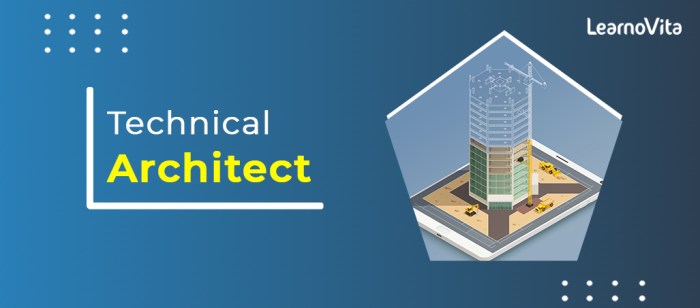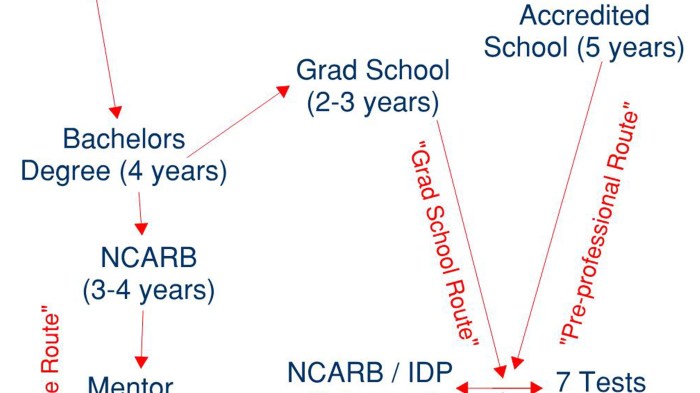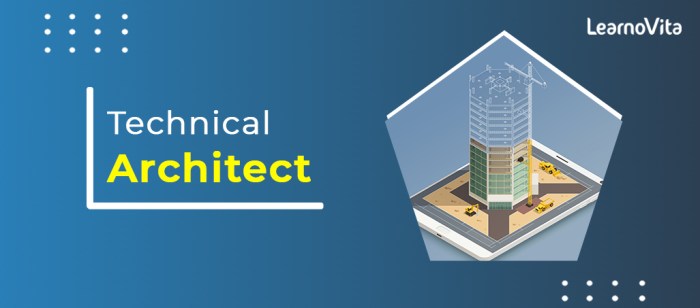
How to become a technical architect? This guide delves into the intricate world of technical architecture, equipping aspiring architects with the knowledge and skills necessary to excel in this demanding field. We’ll explore the core principles, essential skills, and practical strategies required to design, implement, and maintain robust and scalable systems. From foundational knowledge to advanced design techniques, this comprehensive overview provides a roadmap for your journey to becoming a successful technical architect.
This in-depth exploration of technical architecture covers everything from defining the role and its responsibilities to building effective solutions, communication strategies, and continuous learning. We’ll analyze key components like programming languages, software development methodologies, cloud platforms, networking, and system design patterns. Understanding these elements is crucial for anyone aspiring to lead technical projects and make a significant impact in the tech industry.
Defining Technical Architecture
Technical architecture is the blueprint for how a system will be built, encompassing the technology choices, design patterns, and overall structure. It’s a critical aspect of any software or infrastructure project, guiding development and ensuring long-term maintainability and scalability. A well-defined technical architecture minimizes technical debt, promotes collaboration among development teams, and facilitates the seamless integration of new technologies.The technical architect plays a crucial role in translating business needs into a concrete technical solution.
They act as a bridge between business stakeholders and technical teams, ensuring the chosen technologies and design align with the overall business strategy. This crucial role necessitates a deep understanding of various technologies, design principles, and architectural patterns.
Role of a Technical Architect
The technical architect is responsible for defining and maintaining the overall technical strategy of a system or organization. This includes creating the technical design, selecting appropriate technologies, and ensuring the design aligns with business requirements. They play a vital role in the entire project lifecycle, from initial planning to deployment and maintenance.
Key Responsibilities and Tasks
Technical architects have a broad range of responsibilities, encompassing:
- Defining the overall technical architecture, including the components, interactions, and data flow. This often involves creating high-level diagrams, such as system architecture diagrams, and detailing specific components.
- Choosing the appropriate technologies and tools, considering factors like performance, scalability, security, and maintainability. This requires a deep understanding of the available technologies and their strengths and weaknesses.
- Collaborating with stakeholders to understand business needs and translate them into technical requirements. Effective communication and collaboration are essential to ensure the technical solution meets the business goals.
- Creating and maintaining architectural documentation, ensuring consistency and clarity for all involved parties. This documentation often includes detailed diagrams, specifications, and guidelines.
- Reviewing and approving technical designs submitted by developers. This ensures adherence to the established architectural guidelines and standards.
- Troubleshooting and resolving technical issues, offering solutions based on the existing architecture and design principles.
Skills and Knowledge Required
A successful technical architect needs a combination of technical and soft skills. Technical skills include a deep understanding of various technologies, programming languages, and design patterns. They need to be proficient in cloud computing platforms (e.g., AWS, Azure, GCP), databases, and other relevant technologies. Soft skills such as communication, collaboration, and problem-solving are equally important for effective stakeholder management and technical guidance.
Becoming a technical architect requires a blend of technical skills and leadership. A deep understanding of system design principles is crucial, and experience across various technologies is highly beneficial. Amazon’s recent push to make the Kindle more competitive with the iPad, as detailed in this article amazon fires up kindle for battle with ipad , highlights the importance of innovation and strategic thinking.
Ultimately, successful technical architects need to be forward-thinking and able to envision how technology will evolve, and effectively communicate these visions to others.
Types of Technical Architects
The specific responsibilities of a technical architect can vary depending on the area of focus. This table Artikels the distinctions between different types of technical architects:
| Type of Technical Architect | Focus Area | Key Responsibilities |
|---|---|---|
| Cloud Architect | Cloud-based infrastructure and applications | Designing and implementing cloud solutions, optimizing cloud costs, ensuring scalability and availability in the cloud. |
| Data Architect | Data management and warehousing | Designing data models, implementing data pipelines, ensuring data quality and security. |
| Security Architect | Security of systems and applications | Designing secure systems, implementing security controls, ensuring compliance with industry regulations. |
Foundational Knowledge & Skills
Becoming a technical architect requires a robust foundation in diverse areas. It’s not just about knowing a single technology; it’s about understanding how systems interact and how to design scalable, maintainable solutions. This foundation includes a strong grasp of programming languages, software methodologies, database systems, cloud platforms, and networking concepts. This comprehensive knowledge enables technical architects to effectively bridge the gap between business needs and technical implementations.
Core Programming Languages
A deep understanding of core programming languages like Java, Python, and JavaScript is essential for a technical architect. These languages form the building blocks of applications and systems. Proficiency in these languages allows architects to analyze existing code, design new algorithms, and contribute to the development process. For example, Java’s object-oriented nature is beneficial for designing complex, modular systems, while Python’s versatility makes it ideal for scripting and automation tasks.
JavaScript’s dominance in front-end development is crucial for creating interactive user interfaces. A strong command of at least one, and preferably multiple, such languages is paramount.
Software Development Methodologies
Familiarity with various software development methodologies, such as Agile and Waterfall, is critical. Agile emphasizes iterative development, frequent feedback, and adaptability, making it well-suited for projects with evolving requirements. Waterfall, while more structured, provides a clear roadmap for projects with well-defined specifications. Understanding the strengths and weaknesses of each methodology allows architects to choose the most appropriate approach for a given project.
This flexibility is key to success in today’s dynamic software landscape.
Database Systems and Design
A technical architect needs a strong understanding of database systems and design principles. This includes knowing different database types (relational, NoSQL), their strengths and weaknesses, and how to design efficient and scalable database schemas. Understanding data modeling, normalization, and query optimization is essential for creating robust and performant data solutions. Efficient data management directly impacts the overall system performance and scalability.
Cloud Computing Platforms
Cloud computing platforms like AWS, Azure, and GCP are transforming the IT landscape. Technical architects need to be proficient in leveraging these platforms to design scalable, cost-effective, and reliable solutions. Knowledge of cloud-native architectures, security best practices, and cost optimization strategies is critical. Cloud platforms offer various services, from computing resources to storage and databases, making them an integral part of modern system design.
Essential Software Tools
A technical architect utilizes a wide array of software tools for design, modeling, and communication. These tools aid in visualizing architectures, documenting designs, and facilitating communication with stakeholders.
Want to become a technical architect? It’s a journey, not a sprint! Deep dives into various technologies, coupled with strong communication skills, are key. Plus, understanding the latest tech trends, like some of the fascinating, but often overlooked, CES stories that didn’t make the headlines, like these , can give you a competitive edge. Ultimately, hands-on experience and a thirst for knowledge are crucial to building a strong foundation for this career path.
| Tool Category | Example Tools | Purpose |
|---|---|---|
| Architecture Design | Enterprise Architect, Lucidchart | Visualizing system architecture, creating diagrams, and documenting designs. |
| Modeling Tools | UML tools, SysML tools | Modeling system components, relationships, and interactions. |
| Collaboration Tools | Jira, Confluence | Facilitating communication, project management, and documentation. |
| Monitoring and Logging | Prometheus, Grafana | Monitoring system performance, analyzing logs, and identifying issues. |
Networking Concepts
A robust understanding of networking concepts is paramount. This includes knowledge of protocols (TCP/IP, HTTP), network topologies, security considerations, and network design principles. Knowing how data flows across networks, how to secure networks, and how to design scalable networks is essential for architects. This understanding enables them to create reliable and secure communication channels within and between systems.
Building Architectural Solutions

Transforming ideas into robust and scalable applications requires a methodical approach to architectural design. This involves careful consideration of various factors, from choosing the right technologies to anticipating potential risks. A strong foundation in architectural principles is crucial for creating solutions that can adapt to future demands and maintain their efficiency over time.A well-designed application architecture is the bedrock of a successful software project.
It lays the blueprint for how different components interact, ensuring the system remains flexible, maintainable, and scalable. This process goes beyond simply selecting technologies; it involves understanding the specific needs of the application and choosing solutions that best address those needs.
Designing a Scalable Application Architecture
A scalable application architecture is essential for handling increasing user loads and data volumes. The design process should focus on identifying potential bottlenecks and implementing strategies to mitigate them. This involves considering factors such as database design, load balancing, and caching mechanisms. Careful planning in the early stages can significantly reduce the need for costly and time-consuming refactoring later on.
Choosing Appropriate Technologies
Choosing the right technologies is a crucial aspect of architectural design. It involves analyzing project requirements, considering the strengths and weaknesses of different technologies, and selecting the most suitable options. A well-informed decision involves not only evaluating the current capabilities of a technology but also its potential for future growth and integration with other components of the system.
- Consider project requirements: Thorough understanding of the application’s functionality, performance needs, and scalability goals is paramount. A detailed specification document, including anticipated user load and data volume, is crucial.
- Evaluate technology strengths and weaknesses: Each technology has unique strengths and weaknesses. Careful evaluation of factors such as performance, security, maintainability, and cost-effectiveness is essential. Researching reviews and benchmarks from other projects can provide valuable insights.
- Analyze compatibility and integration: Ensure the chosen technologies can seamlessly integrate with existing infrastructure and future additions. Compatibility issues can lead to significant development delays and integration challenges.
Comparing Architectural Styles
Understanding different architectural styles is crucial for selecting the best approach for a particular project. Different styles offer varying trade-offs in terms of scalability, maintainability, and development complexity.
- Microservices: Microservices architecture divides an application into independent, small services. This approach enhances scalability and maintainability, but can introduce complexities in service communication and data management.
- Monolithic: A monolithic application bundles all components into a single unit. This approach is simpler to develop initially, but can become challenging to scale and maintain as the application grows.
System Design Patterns
System design patterns provide reusable solutions for common architectural challenges. Understanding and applying these patterns can significantly improve the efficiency and effectiveness of the design process. Common patterns include caching, load balancing, and message queues.
Challenges and Solutions in Architectural Design
| Challenge | Solution |
|---|---|
| Scalability issues | Employ appropriate technologies, implement load balancing strategies, and optimize database queries. |
| Integration complexities | Develop clear APIs, utilize standardized protocols, and maintain comprehensive documentation. |
| Security vulnerabilities | Implement robust security measures, employ encryption techniques, and conduct regular security audits. |
| Maintaining consistency | Utilize design patterns, establish clear guidelines, and enforce code standards. |
Identifying and Mitigating Technical Risks
Anticipating and mitigating potential technical risks is a critical part of the design process. This involves identifying potential problems, assessing their impact, and developing strategies to reduce or eliminate them.
Risks can include compatibility issues, performance bottlenecks, and security vulnerabilities. A risk assessment should include both short-term and long-term consequences, and the likelihood of each risk materializing.
Communication & Collaboration
Effective communication and collaboration are paramount to a technical architect’s success. They bridge the gap between technical specifications and stakeholder needs, ensuring projects align with business goals. A strong communication style fosters trust, clarifies expectations, and prevents misunderstandings, leading to more efficient and successful outcomes. Without clear communication, even the most sophisticated technical solutions can fail to deliver value.
Importance of Communication Skills
Technical architects need strong communication skills to convey complex technical concepts to non-technical stakeholders. This includes translating technical jargon into easily understandable language and tailoring the message to the audience’s level of understanding. This ensures that stakeholders can grasp the implications of architectural decisions and provide valuable input. Furthermore, clear communication fosters transparency and accountability, crucial for successful project management.
Best Practices for Collaboration with Stakeholders and Developers
Collaboration with stakeholders and developers is a continuous process, requiring active listening, empathy, and the ability to articulate ideas clearly. Active listening ensures that the architect understands the needs and concerns of both stakeholders and developers. Empathy helps in tailoring communication styles to resonate with different personalities and backgrounds. A strong architect facilitates a collaborative environment where ideas are shared and discussed openly.
Regular meetings, clear communication channels, and documented agreements are crucial for successful collaboration. Regular feedback loops are essential for adapting solutions to evolving needs.
Becoming a technical architect takes a blend of technical skills and leadership. You need a strong foundation in software design principles and a knack for understanding complex systems. This often involves hands-on experience, like working on large-scale projects and leading teams. Expect Labs’ anticipatory computing, which draws a list of support , highlights the importance of forward-thinking in this field.
Ultimately, continuous learning and staying updated with the latest tech trends are key to mastering this challenging yet rewarding career path.
Role of Documentation in Technical Architecture
Comprehensive documentation is essential for technical architecture. It serves as a repository of knowledge, a guide for future developers, and a reference point for troubleshooting. Well-documented designs are easier to understand and maintain, reducing errors and improving project efficiency. Documentation should be kept up-to-date and readily accessible. It should clearly define system components, interfaces, and technical specifications.
Clear diagrams and mockups should supplement textual descriptions, enhancing comprehension and maintainability.
Examples of Effective Technical Presentations
Effective technical presentations require a balance of visuals and concise explanations. Technical architects should focus on delivering key takeaways, using visuals like diagrams, flowcharts, and prototypes to illustrate complex concepts. The presentation should be tailored to the audience, avoiding overly technical jargon when possible. Practice and rehearsal are crucial for delivering a smooth and engaging presentation. Examples include presenting architectural designs to stakeholders using interactive whiteboards or using tools like PowerPoint with well-organized slides and visual aids.
Table of Communication Channels
This table illustrates various communication channels suitable for technical architects.
| Communication Channel | Description | Best Use Case |
|---|---|---|
| Face-to-face meetings | Direct interaction for detailed discussions. | Stakeholder presentations, project kickoff meetings, problem-solving sessions. |
| Formal communication for updates and follow-ups. | Document sharing, project updates, and scheduling. | |
| Instant messaging (Slack, Teams) | Quick communication for questions and immediate responses. | Daily project updates, quick questions, and discussions. |
| Project management tools (Jira, Asana) | Centralized platform for tasks, progress tracking, and communication. | Project tracking, assigning tasks, and coordinating with developers. |
| Technical documentation | Formal record of designs and specifications. | Defining technical architecture, specifications, and procedures. |
Role of a Technical Architect in Facilitating Technical Discussions
A technical architect acts as a facilitator in technical discussions, guiding the conversation towards a shared understanding. They ensure that technical concepts are presented clearly and that different perspectives are considered. This role involves asking clarifying questions, summarizing key points, and ensuring everyone understands the implications of decisions. The architect promotes open dialogue, encouraging participation from all stakeholders and developers.
Continuous Learning & Development
Staying ahead in the ever-evolving world of technical architecture requires a proactive approach to continuous learning and development. This is not a one-time effort but a lifelong commitment to mastering new technologies, understanding emerging trends, and refining your architectural skills. Continuous learning allows technical architects to adapt to changing business needs and deliver optimal solutions.Embracing a growth mindset is crucial for success in this field.
A commitment to ongoing learning and development fosters adaptability, innovation, and the ability to effectively address complex technical challenges. This commitment is key to providing value and ensuring long-term career progression.
Continuous Professional Development Roadmap
A well-structured roadmap for continuous professional development helps you stay organized and focused on your learning goals. This roadmap should include both short-term and long-term objectives, aligning with your career aspirations and the industry’s evolving demands. Prioritize areas of interest and focus on acquiring in-depth knowledge in specific domains.
Industry Trend & Technology Updates
Staying abreast of industry trends and emerging technologies is vital for technical architects. These trends shape the future of architecture and influence the solutions we design. Engage with industry publications, attend webinars, and actively participate in online communities. Following thought leaders and experts in the field is an important aspect of keeping up with the latest advancements.
Significance of Industry Certifications
Industry certifications validate your technical expertise and demonstrate your commitment to professional development. These certifications often showcase a deep understanding of specific technologies or methodologies, enhancing your credibility and marketability. Certifications often involve rigorous study and testing, demonstrating your dedication and expertise. This can be an important aspect of career advancement and recognition.
Recommended Learning Resources
Staying updated with the latest knowledge requires a commitment to learning. This includes reading books, articles, and engaging with other professionals in the field. A mix of formal and informal learning methods is crucial.
- Books:
- Microservices Architecture by Sam Newman: A practical guide to designing and implementing microservices, covering essential concepts and real-world examples.
- Designing Data-Intensive Applications by Martin Kleppmann: A comprehensive exploration of data systems, emphasizing the principles behind scalable and reliable architectures.
- The Phoenix Project by Gene Kim, Kevin Behr, and George Spafford: A fictional story that illustrates the principles of DevOps, highlighting the importance of collaboration and communication in achieving technical goals.
- Articles:
- Publications from reputable sources such as Gartner, Forrester, and industry-specific journals. Follow industry blogs and websites to gain insight into current trends.
Networking with Other Technical Architects
Networking with other technical architects is invaluable. Sharing experiences, best practices, and insights with peers fosters professional growth and helps you stay connected with the latest industry developments. Joining online communities and attending industry events are effective strategies for networking.
Online Courses & Training Programs
Utilizing online courses and training programs allows you to expand your knowledge and gain new skills at your own pace. They provide a structured approach to learning, with different platforms and course providers offering various options. Selecting programs relevant to your specific needs and goals is crucial.
| Platform | Course Name | Description |
|---|---|---|
| Coursera | AWS Certified Solutions Architect – Professional | Gain expertise in Amazon Web Services cloud architecture. |
| edX | Designing Data-Intensive Applications | Explore the fundamentals of building large-scale data systems. |
| Udemy | Microservices Architecture | Learn the principles and practical application of microservices. |
| Pluralsight | Various cloud-based courses | A broad range of courses covering different technologies and concepts. |
Case Studies & Examples
Real-world examples illuminate the practical application of technical architecture principles. Analyzing successful and challenging projects provides valuable insights into adapting to evolving business needs, handling scaling, and understanding the impact of architectural choices. Examining diverse projects allows us to identify best practices and pitfalls, leading to more informed decisions in our own architectural endeavors.
E-commerce Platform Migration
A significant case study involves migrating an e-commerce platform from a legacy system to a cloud-based architecture. This project required a thorough understanding of the existing system, a detailed assessment of the new platform’s capabilities, and a careful planning phase to ensure minimal disruption to operations. Technical architects played a crucial role in defining the migration strategy, selecting appropriate cloud services, and designing the data migration process.
- Legacy system analysis: Understanding the existing database structure, application logic, and dependencies was essential to developing a migration plan.
- Cloud platform selection: Factors like scalability, security, and cost-effectiveness drove the decision on the cloud provider and specific services.
- Data migration strategy: This included data transformation, validation, and loading procedures to ensure data integrity and minimize downtime during the migration.
Microservices Architecture for a Financial Application, How to become a technical architect
Migrating a monolithic financial application to a microservices architecture demonstrates adaptability to evolving business needs. This transition required a clear understanding of the application’s functionality, identification of potential service boundaries, and a robust communication strategy for the new microservices. This approach allowed for independent scaling of individual services, enhancing responsiveness and efficiency.
- Service decomposition: Breaking down the monolithic application into smaller, independent services based on business capabilities.
- API design and communication: Defining clear API contracts to ensure seamless communication between services.
- Containerization and orchestration: Utilizing Docker and Kubernetes to manage the deployment and scaling of microservices.
Scalability in a Social Media Platform
A social media platform faced challenges in handling a sudden surge in user traffic. Technical architects implemented a solution by utilizing a distributed caching layer, load balancing, and horizontal scaling of servers. This demonstrated the importance of proactive design considerations for scalability and high availability.
- Performance analysis: Identifying bottlenecks and resource limitations to understand how the platform behaved under stress.
- Caching implementation: Implementing a caching strategy to reduce database load and improve response times.
- Load balancing configuration: Distributing incoming traffic across multiple servers to prevent overload.
Impact on Business Outcomes
Successful technical architecture implementations directly impact business outcomes. For example, a well-designed e-commerce platform can increase sales conversions, improved customer satisfaction and reduced operational costs. Similarly, a scalable social media platform can enhance user engagement and brand recognition. These positive outcomes are often directly correlated to the clarity and thoroughness of the architectural decisions made.
- Increased efficiency: Streamlined processes and automated tasks resulting from well-defined architectures.
- Improved scalability: The ability to handle increased demand without compromising performance.
- Enhanced security: Implementing robust security measures from the start reduces vulnerabilities and risks.
Concluding Remarks: How To Become A Technical Architect

In conclusion, becoming a technical architect is a multifaceted journey requiring a blend of technical expertise, strong communication skills, and a commitment to continuous learning. This guide has provided a comprehensive framework, from understanding fundamental concepts to designing robust solutions and effectively communicating with stakeholders. By mastering the skills Artikeld in this guide, you’ll be well-equipped to navigate the complexities of modern technical architecture and shape the future of technology.
Now go forth and build!






